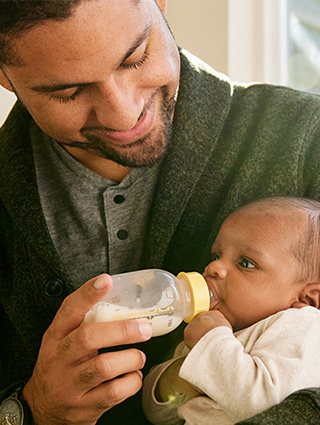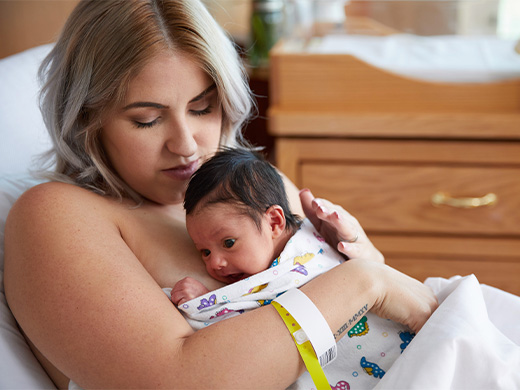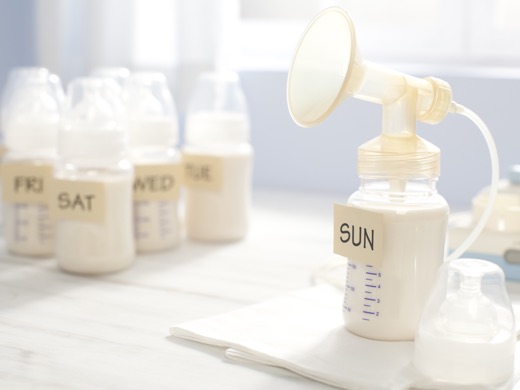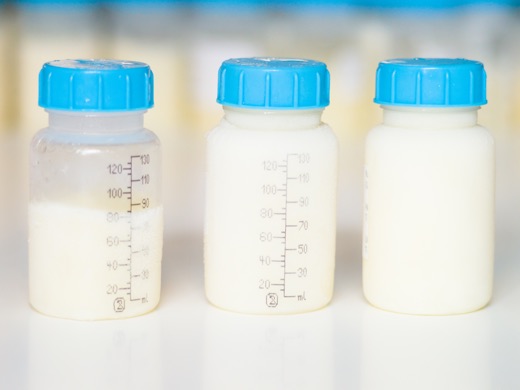Breastfeeding Support 24/7: 855-550-6667
The basics of bottle feeding
Many moms who breastfeed like the option to pump their breastmilk and bottle feed as well. Pumping allows you to provide your baby with breastmilk when you are separated and helps maintain your milk supply when you’re unable to nurse on a regular schedule.
Tips for bottle feeding success
Moms may have many reasons why they begin bottle feeding their baby – and they may have lots of questions, too! In this article, you will learn:
- When you should introduce a bottle to a breastfed baby
- What paced bottle feeding is and how to do it
- Ways to address bottle feeding concerns, like keeping up your milk supply or what to do if your baby refuses the bottle
- How to wash pump and bottle parts
- Tips on bottle feeding with formula, including a video on safe formula prep
Let’s start by talking about how and when to introduce a bottle to your baby.
When should you introduce a bottle to a breastfed baby?
The first few weeks are the most important for setting your milk supply. If possible, focus on exclusively breastfeeding for the first 3-4 weeks of your baby’s life so you can build a strong milk supply before introducing a bottle. Bottles can be introduced when your baby is 4 weeks old or two weeks before you return to work or school, whichever is sooner. Try to start bottle feeding before your baby is 6 weeks old so that she has an easier time adjusting between the bottle and the breast.
Are you still a little unsure about starting bottle feeding with your baby? Listen to our Mom Team talk about making the transition.
What is paced bottle feeding?
Paced bottle feeding gives babies more control over the milk flow and how much they drink from a bottle. It imitates breastfeeding better than other forms of bottle feeding and is a good way to transition from breast to bottle when you and your baby are ready.
If your baby is in the care of someone else, such as a friend, family member or child care provider, it’s a good idea to encourage them to use paced bottle feeding as well.
How to Pace Bottle Feed
- Hold your baby in an upright position.
- Touch your baby’s lip to the bottle nipple and wait for her to open her mouth.
- Hold the bottle horizontally to slow down the flow of milk when bottle feeding. It’s ok if there is a little air in the nipple.
- Your baby should latch deeply. A longer, thinner bottle nipple with a wider base works well for deep latches.
- Your baby will start drinking. After 5 to 10 seconds, give her a break by lowering the bottle or taking the bottle from her mouth and resting the nipple on her cheek. Your baby will start searching for the bottle with her mouth when she is ready for more.
- The paced bottle feeding is over when your baby gives you cues that she is full, such as turning away from the bottle or relaxing her fists.
- It’s ok if your baby doesn’t finish the bottle. When first introducing a bottle, include less breastmilk than you think your baby will need and add more as she shows cues she is still hungry.
- Throw away any breastmilk left in the bottle two hours after the feeding is done.
When using paced bottle feeding, it will typically take about 15 minutes for your baby to give you the “I’m full” signal.
Expert Tip
“Be sure that anyone bottle feeding your baby uses a paced bottle feed to make it easier for your baby to switch back and forth between the bottle and breast.”
Michelle P., WIC IBCLC
Common bottle feeding concerns
Keeping Up the Milk Supply
It’s important to remember that your milk supply is based on a supply and demand system. The more milk your baby or pump takes, the more your body makes. Every time your baby bottle feeds, you need to replace this missed breastfeeding with a pumping session somewhere in your day. For example, you can pump after a morning breastfeed – or any time that works for you – and then offer the milk in a bottle at another point during the day. Many mothers pump after a morning breastfeed and have their partner give this milk during an overnight feeding.
Some pumping sessions may produce more milk than your baby will need for a bottle feeding. In those cases, you can store the milk in the fridge or freezer to use later. Whether you’re breastfeeding or pumping, make sure you’re doing it often enough to continue sending those “make milk” signals to your body. This will mean 8 to 12 nursing or pumping sessions each day. Don’t go longer than one 6-hour stretch in a 24-hour period without removing milk.
The easiest way to keep your milk supply up through pumping is to set a schedule. Even if you’re away from home, keeping a hand pump or electric pump with you throughout the day can help you keep a regular pumping routine.
How Much Milk Do I Put in the Bottle?
Most babies between the ages of 1 and 6 months will take between 3 to 5 ounces of milk in place of a breastfeeding session. If your baby is only bottle feeding, plan on about eight bottles each day with your baby drinking 24 to 36 ounces of milk every 24 hours. Your baby’s doctor and WIC can help make sure your baby is drinking the right amount by tracking her weight gain. Just like when breastfeeding, look for cues signaling your baby is hungry or full and follow her lead. When your baby stops opening her mouth or rooting for the bottle, turns her head away, arches her body, or falls asleep, the feeding is finished. Never force a baby to finish a bottle once they’ve given you “I’m full” cues.
If your baby does not finish the bottle, the leftover breastmilk can still be used within 2 hours after she is finished feeding. After 2 hours, leftover breast milk should be thrown away. Once your baby’s mouth touches the nipple, bacteria from her mouth is introduced into the milk. After 2 hours, the bacteria in the milk may be at levels high enough to make your baby sick.
If you have any formula in the bottle, you’ll need to use it within 1 hour from when the feeding begins.
To limit wasting milk when first introducing a bottle to a breastfed baby, try offering 1 to 2 ounces of pumped milk in the bottle and keep the remainder in the fridge. You can add more milk as your baby gives cues that she is still hungry. This way, you can limit how much pumped milk you throw away after two hours.
Do I Need to Warm the Bottle?
Some babies prefer to have warmed breastmilk while some won’t mind whether their milk is warm or cold. To warm breastmilk, run the bottle under warm water or place it in a bowl of warm water. Never microwave breastmilk, as it will heat unevenly and create hotspots that could burn your baby.
Bottle Refusal
We recommend introducing the bottle by the time your baby is 6 weeks old to help reduce the risk of bottle refusal, especially if you must return to work or school. Start by giving your baby one bottle a day or every other day to keep practicing switching back and forth.
If your baby won’t take the bottle, reach out to a WIC lactation consultant or peer counselor. They can help you create a plan. Trying different bottles, nipples, flow speeds, times, temperatures, locations and caregivers are some of the most common strategies to help your baby take a bottle. Be sure your baby isn’t too hungry when trying to bottle feed. Keep things fun and light and never force it, as this tends to make bottle refusal worse.
Washing pump and bottle parts
The Centers for Disease Control and Prevention (CDC) recommends washing your pump and bottle parts after every use.
After each use:
- Take apart and separate all parts that come in contact with the breast or breastmilk.
- After pumping, this includes flanges, valves, membranes, connectors, and milk collection bottles. If you have an open-system pump, clean the tubing according to the manufacturer’s instructions. If you have a closed-system pump, you don’t need to wash your tubing as it doesn’t come in contact with the milk.
- After bottle feeding, this includes the nipple, nipple ring, bottle cap and bottle.
- Rinse breast pump and bottle parts that come into contact with the breast or breastmilk under running water to remove remaining milk.
- Clean by hand or dishwasher.
If cleaning by hand:
- Place the above items in a basin used only for infant feeding items, not directly into the sink.
- Fill the basin with hot, soapy water.
- Scrub items using a clean brush used only for infant feeding items.
- If washing after bottle feeding, squeeze water through the nipple hole to ensure it gets cleaned.
- Rinse items again under running water and allow to air dry.
- Place bottle parts, basin, and bottle brush on a clean, unused dish towel or paper towel and allow to air dry.
If cleaning in the dishwasher:
- Place all items in the dishwasher, placing small items like valves inside a closed basket so they don’t get lost.
- If possible, run the dishwasher using hot water and a heated drying cycle (or sanitizing setting).
- Remove items from the dishwasher with clean hands. Allow items to air dry on a clean, unused dish towel or paper towel.
Sanitizing Pump and Bottle Parts
The CDC recommends daily sanitization of bottles and pump parts for premature or sick babies and any baby under 2 months old. Talk to your pediatrician if you have questions about pump and bottle sanitization.
Note: If you use a dishwasher with hot water and a heated drying cycle (or sanitizing setting) to clean infant feeding items, a separate sanitizing step is not necessary.
Read your pump’s manual to see if there is guidance specific to your pump.
To sanitize:
- After cleaning by hand, place disassembled breast pump items and bottle parts that are safe to boil in a large pot and cover with water.
- Boil for 5 minutes.
- Remove items from the pot with tongs and place them on a clean dish towel or paper towel to air dry.
Bottle feeding with formula
Breastfeeding doesn’t have to be all or nothing. Though most moms have the right to pump in the workplace, some moms may decide to only pump or breastfeed in the evenings after school or work, meaning that they use formula during the day. It’s important to note that starting or increasing formula use can decrease your breastmilk supply if you don’t pump regularly. We recommend pumping each time your baby takes a bottle. If you’re concerned that you’re not making enough milk, have questions about supplementing with formula, or need more guidance, call your WIC peer counselor or talk to a lactation consultant to create a plan that works best for baby and you.
For more information on how to safely prepare formula for your baby, watch our Mom Team explain the basics.
WIC is here to help you meet your breastfeeding goals. If you have questions about your milk supply or want more information on the best time to introduce a bottle, talk to someone at your local WIC clinic or call the free 24/7 Texas Lactation Support Hotline at 855-550-6667.




